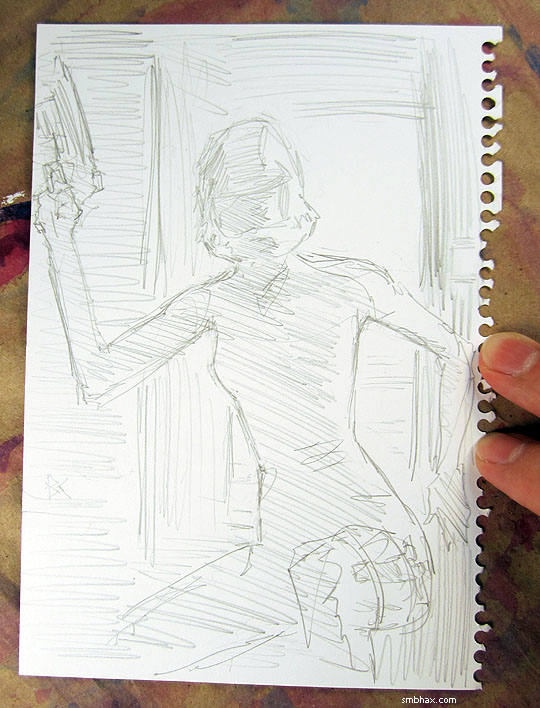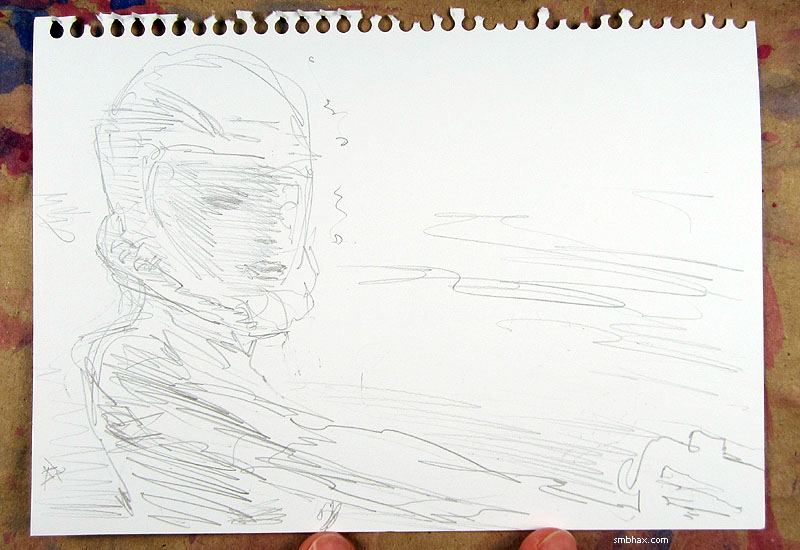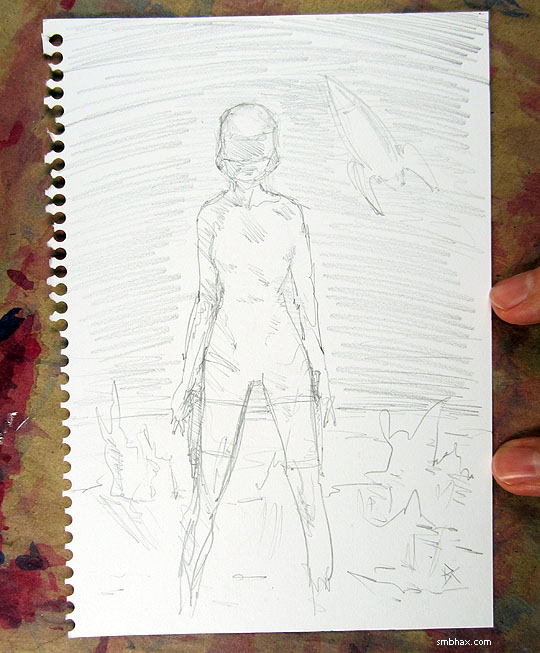 | |
|  |
|
|
view titles only (low bandwidth) |
| |
| But can geckos climb in spaaaaaace? | Nov 29, 2014 3:21 AM PST | url |
| | |
Added 1 new A* page:Woo Supermassive Black Hole Friday! You know, I always figured Selenis' space suits had some way to stick to the outer hulls of spacecraft and as far as I thought it through I thought maybe it would be electromagnets or something, although that would require the outer hulls to be ferromagnetic, which seems pretty unlikely to be the case always. Anyway maybe there's a better way...via geckos! Or so US military research group DARPA is hoping, as, according to this BBC article, they're funding research into climbing pads that utilize the Van der Waals force to stick to things like geckos do. Actually "the sum of the attractive or repulsive forces between molecules," the Van der Waals force, as it is called, is "very weak," but "the effect is multiplied across the many tiny hairs that cover the toes of a gecko, allowing them to stick firmly to surfaces," and in a DARPA-funded Stanford test, "the Stanford team created tiny tiles called microwedges to harness van der Waals forces. They were able to produce a dry adhesive even more efficient than that of the gecko," which was demonstrated by a human climber climbing a glass wall by means of microwedge-coated pads.
Something like that could have come in handy for Selenis just recently here, in her dash out of the salvage room just before the life support module blew up: in low gravity as we have here on this icy little moon, it would be really hard to launch into a mostly horizontal flying leap with any kind of velocity to it—since you're pushing off the floor, you'd tend to fly up at least as much as across—UNLESS maybe you were able to cling to the floor just a bit as you pushed off, maybe even getting a hand down for additional directional effect. Hm, I wonder if geckos have been tested in low gravity...
Ah, well, although a Russian-based test of five geckos in space earlier this year to test the effect of microgravity on their mating habits resulted in five frozen geckos after the satellite they were on experienced a widely publicized loss of control, there were three geckos-in-space tests prior to that, going back to 2005, basically to see if vertebrates can a) survive and b) reproduce in space; up until the latest test they had, at least survived. But they haven't been testing their adhesive/locomotive powers, per se.
|
·····
|
| |
| A strange Selenis sketch | Nov 27, 2014 12:02 AM PST | url |
| | |
Added 1 new A* page:Here's a sketch I sent off recently to a reader <33 as their reward for supporting the comic through my Patreon campaign in the month of September:

Okay now don't forget that I won't be doing a page tomorrow (Thursday, anyway) because I'm off doing the wacky Thanksgiving stuff we do here. Whether or not you're doing that, I hope you have a good Thursday too! And after that...more A*!
|
·····
|
| |
| Holiday notes aka stuff I will do next week | Nov 25, 2014 9:43 PM PST | url |
| | |
Added 1 new A* page:A reader sent me to a web article called Seeing Through Our Galaxy, which by means of a lot of high resolution images demonstrates the improved view you can get of the center of our galaxy—with A* in there somewhere!—when you use instruments that look at it in longer wavelengths, which are better at seeing through all the interstellar dust and gas that's in the way. Neat pictures!
~~~~~~~
If you're celebrating the Thanksgiving holiday this Thursday, you'll be relieved to know that you won't have to interrupt the festivities to keep up with the latest A* page, because I'll be celebrating as well and won't be getting a page done on that day! I don't think.
~~~~~~~
My dad and I will be putting up a show of A* artwork at a local Seattle restaurant over the weekend, and I'll get you the details of that next week so you can go check it out during the month of December if you're in the area and needing to have framed A* prints looming over you as you eat. : o
~~~~~~~
This past weekend I woke up super early one day with the weird urge to paint a big A* painting, so I did! And I was going to put it up for auction today and make a big blog post about it but then I realized that would mean the bulk of the auction would be upstaged for a lot of folks by the long holiday weekend, and gee I wouldn't want any of you to miss it. So that will have to wait until next week as well! Hmmm probably Tuesday I'm thinking. Anyway it's by far the biggest watercolor painting I've ever done and maybe it's just the sleep deprivation talking but I think it came out pretty well!
|
·····
|
| |
| A glance askance--it's another sketch! | Nov 25, 2014 12:06 AM PST | url |
| | |
Added 1 new A* page:Here's a sketch a reader received a little while back as the reward for their support of the comic through the A* Patreon campaign in September:

Thanks, reader!! Patreon is a service that makes it easy to send your favorite creators a few bucks a month to help them out, and it's been a huge help for me while I make this comic!
|
·····
|
| |
| Supermassive Holiday Sale! All A* art $10 off | Nov 22, 2014 9:41 AM PST | url |
| | |
Added 1 new A* page:Okay so I am really badly jumping the Black Friday gun for the...Supermassive Holiday Sale! Yes, from now through the first week of January, my original art that you can buy on this site (look for the gold "original art" link to the lower left of A* comic page images, for instance) is $10 off! That means that the watercolor and ink pages are just $40 instead of $50, and the pencil pages (episode 19 and the beginning of 20) are just $15! The art in the episode-related art galleries (see the episodes & e-books page is similarly sale priced. Although most of my watercolor painted pages lately have been selling straight off the bat—thank you!!—there are still some left even from recent episodes, fer instance:
Episode 23, page 5:

Episode 22, page 105:

Episode 22, page 62:

It's the perfect time to get a unique piece of A* art for that special someone on your list! Or...okay so we know you're getting it for yourself. That's fine too! :D Make it an A* X-mas, or whatever you'd like to celebrate. Remember, the sale prices will only be around through the first week of January!
|
·····
|
| |
| A European service module for Orion | Nov 21, 2014 4:24 AM PST | url |
| | |
Added 1 new A* page:Earlier this week came the news that Europe signs on to Orion venture (BBC) - The ESA ("European Space Agency") has signed a contract to make the service module for the American "Orion" spacecraft intended eventually to take a manned mission to Mars; Lockheed Martin is building the other half, the "Orion capsule," which will house the crew; a stripped-down version is due for a preliminary test flight next month.
The service module will be based largely on the ATV ("Automated Transfer Vehicle") that the ESA has been using to ferry supplies to the International Space Station; the ATV is seen as having a reliable service record. And they're counting on another reliable performer in putting together the service module: the main thruster will be an old Space Shuttle engine.
The business end of the deal is a nice illustration of how international space stuff gets done: "America will pay nothing for the service module because it is being given as payment in kind to cover costs Europe will incur at the International Space Station from 2018 through 2020. It is part of a barter agreement - something that has become standard practice over the 16-year history of the ISS."
|
·····
|
| |
| Satellites following other satellites | Nov 20, 2014 5:08 AM PST | url |
| | | |
Added 1 new A* page:Russia tests 'satellite catcher' (BBC), but, as the article points out, the US and China have already tested similar satellites this year: satellites or parts of satellites that can track and pursue other satellites. One obvious use for this is disabling "enemy" satellites, but it can also be used to retrieve errant satellites. These satellites appear to use their own AI routines rather than guidance from the ground for their close shadowing techniques.
|
·····
|
| |
| Comet-lander Philae's final findings? | Nov 19, 2014 6:16 AM PST | url |
| | |
Added 1 new A* page:Some fascinating new details and developments have emerged in the saga of the ESA's Philae probe, which made mankind's first-ever landing on a comet last week—a very bumpy landing! The lander's mother ship, Rosetta, in orbit around the comet, had a pretty good view of the action, and we now have a composite image showing its view of the landing and following bounce, which sent the 100 kg lander on an unexpected two hour, 1 km-high loop back up into space; they figure that for it to have bounced that much, the surface must have been much harder than they'd expected, with very little soft dust covering water ice having what is thought to be the tensile strength of sandstone. The probe came to rest hundreds of meters away from the intended landing spot, in a shadow-covered area where its solar panels don't get enough sunlight to keep it going—kind of a huge bunker shot, really, to throw in an unnecessary sports analogy!
But before its charge died, it did get to conduct some experiments on its surroundings, and the data coming out of those is pretty interesting! It detected organic molecules in the comet's extremely thin atmosphere, which means it sniffed carbon compounds of the type that, when brought together under conditions like we had on the primitive Earth—say warm, moist, and hit with a lightning bolt or two—are thought to be capable of forming self-replicating structures: the beginning of life as we know it! Well that's just a theory, but finding them on this comet strengthens the further theory that comets played a role in bringing the building blocks of life to Earth.
Philae's hammer test suggests that it landed in a 10-20 cm-deep layer of dust over that sandstone-strength water ice. The lander's drill did not find organic molecules like the sniffer did, but the lander is laying on its side somehow, and they aren't sure the drill actually got into the surface.
The last article also mentions a theory that once the comet gets close enough to the Sun, the lander will start getting enough sunlight to power up again...hopefully with time to do some more testing before it melts. : o
~~~~~
If you need another webcomic tracking site to keep track of A* and all the other comics you read online, you can now follow A* through Webcomics Hub, a new webcomic tracking site with a pretty slick interface.
|
·····
|
| |
| An ink sketch for Patreon! | Nov 18, 2014 4:54 AM PST | url |
| | |
Added 1 new A* page:Here's a sketch I mailed off to a supporter of the A* Patreon campaign recently, as the reward for their support in the month of September:

Thanks to everyone who's helping keep this comic going by supporting me through Patreon! <3
|
·····
|
| |
| Spot the differences! | Nov 15, 2014 12:43 AM PST | url |
| | |
Added 1 new A* page:Well the Philae comet lander did indeed run out of power after landing off-course in the shadow of a crater's lip on comet 67P, but it got to drill into the comet first and run some other experiments, and send back the results, so we'll see if anything interesting comes out of that data. There's a chance Philae could catch enough sunlight at some point to wake back up for a little while. Meanwhile, its mothership, Rosetta, will continue to orbit the comet for the next 13 months or so as 67P arcs toward the Sun.
~~~~~
Here's a sketch I mailed off recently to a supporter of the A* Patreon campaign, where readers help me keep producing this webcomic by automatically sending me a few bucks each month <3<3<3:

It doubled as a practice sketch for what ended up as page 11 of this episode.
|
·····
|
| |
| A dark outlook for the Philae lander! | Nov 14, 2014 8:27 AM PST | url |
| | |
Added 1 new A* page:Continuing on from yesterday's article about the ESA's Philae lander successfully making mankind's first landing on a comet—the comet 67P/Churyumov-Gerasimenko—comes more information giving the mission team a better understanding of the lander's situation after the tethers that were supposed to secure it to the comet failed to deploy during landing. It appears to have gotten itself into a pretty tight spot!
Rosetta: Battery will limit life of Philae comet lander (BBC) - The lander bounced twice off the hard cometary surface (they hadn't been sure if it would be hard or soft), the first bounce taking it 100m away from its intended, relatively smooth landing spot; it came to rest on just two of its three legs in the shadow of a small cliff, possibly the rim of a crater. Unfortunately, the cliff is blocking most of the sunlight the probe was supposed to be receiving and using for power once its main battery runs out: "It means Philae is unlikely to be operating in its present state beyond Saturday."
Comet lander: Future of Philae probe 'uncertain' (BBC) - The team has deployed the lander's drill in an attempt to get a sample from the surface of the comet before the power runs out; there's also a very slim hope that the drill will be able to push it away from the shadow of the cliff and into more sunlight to extend its battery life—but at this point every communication with the lander could be its last.
|
·····
|
| |
| ESA makes mankind's first landing on a comet | Nov 13, 2014 5:28 AM PST | url |
| | | |
Added 1 new A* page:The ESA's Philae lander landed on comet 67P/Churyumov-Gerasimenko today and sent back a photo from the surface. It's mankind's first ever landing on a comet, and actually it was three landings; the harpoons that were supposed to tether Philae to the comet's surface failed to deploy, so the lander bounced twice before settling on the comet; there was a great deal of consternation after it was discovered the harpoons hadn't fired, because it wasn't clear whether or not Philae had landed successfully or landed and bounced off into the void, and there is still some concern that trying to drill into the comet to test its composition will fling the untethered lander into space, since "gravity on the comet is 1/100,000th that of Earth, meaning the washing machine-sized lander weighs just 1 gram (0.04 ounces) there." It is also possible that the tethers can still be fired, but whether or not this would be likely to help at this point is still being investigated.
|
·····
|
| |
| A subsurface sketch! | Nov 12, 2014 5:11 AM PST | url |
| | |
Added 1 new A* page:Here's a sketch I mailed off to a reader a little while back as the reward for their support of the A* Patreon campaign in September:

Thanks to them and all the other folks helping me out with a buck or however many each month on Patreon! It's a big help! : )
|
·····
|
| |
| I have a question about shock waves & gravity | Nov 11, 2014 4:55 AM PST | url |
| | |
Added 1 new A* page:The sequence of the previous two pages, with the torpedo exploding above Selenis and then the ice crashing down on her, touched off a couple interesting discussions with readers about the effects of underwater explosions, mainly that shock waves underwater are much more serious business than those in air; I'd read that on Wikipedia's Underwater explosion page when I posted the link to it a few pages back, and if I'd thought about it really in depth I could have just had the blast wave from the explosion KO Selenis, but I had been looking forward to dropping the ice shelf on her for so long that I didn't really consider it. ; ) Also, every time I draw an explosion, I should do so with the disclaimer that the explosions in the drawings are not as close as they appear—it seems I can't help exaggerating them a bit for effect! :"P Here, the torpedo was supposed to have traveled a pretty good distance past Selenis before it hit the ice, so she wasn't intended to appear to be right next to the explosion or anything, exactly.
The discussions did bring up a factor that could be pertinent in low-gravity situations such as this one, though (this moon is relatively tiny, and thus has only a fraction of standard Earth gravity), and that is the question of water pressure on shock wave strength. Wikipedia says
| Mass and incompressibility – water has a much higher density than air, which makes water harder to move (higher inertia). It is also relatively hard to compress (increase density) when under pressure in a low range, say up to 100 atmospheres. These two together make water an excellent conductor of shock waves from an explosion. |
Water pressure varies directly with gravity (since the water on top of you weighs less), so the water pressure here is pretty low, and over the weekend I was thinking at first that that would mean the density was lower, and shock waves wouldn't be as bad. But now that I've re-read the article and seen the part about water not compressing much in the "low range" anyway, I *guess* shock waves in this low gravity ocean wouldn't be all that much different from our standard gravity Earth oceans. Would they? Googling didn't turn up much on this, maybe because putting "pressure" in just gives hits about the pressure of the shock wave itself, or because it's something that's totally obvious if you know the math, which I of course do not. ; )
Anyway, the ice won—this time! : P
|
·····
|
| |
| Free stars; G2 "cloud" skips A*; Baby planets | Nov 08, 2014 11:31 AM PST | url |
| | |
Added 1 new A* page:The BBC had a trifecta of pretty interesting space news articles a day or two ago:
- Background light suggests many stars 'outside galaxies': There is more light coming in than the galaxies we know about can account for, apparently, and a new analysis of this light, reading certain types of "ripples" in it, has inferred that "as many as half" of the stars in the universe may be floating free in the vast spaces between galaxies, rather than concentrated in galaxies themselves—but this finding is contested, as others say the light could be coming from very very distant galaxies. Anyway, you don't often hear much about the stars that certainly must be drifting freely through intergalactic space in large numbers, but this article goes on about them at some length.
- Mystery over monster cosmic cloud: Astronomers studying Sagittarius (aka "Sgr") A*, the supermassive black hole at the center of our galaxy, for a while now have been making much of a large gas cloud, dubbed G2, that seemed on a collision course with the black hole, anticipating that they'd get to see what would happen as the hole tore the cloud apart. But that...didn't happen; instead, G2 passed its closest approach (36 light hours) to A* perfectly intact, defying simulations of what should happen to a gas cloud passing that close to a black hole of 4 million solar masses. So now some astronomers are concluding that G2 must be a star, rather than a gas cloud—like maybe a binary star system that merged into one star on its way in toward A*. This, also, is contested. ; ) There's a more credulous and perhaps less balanced discussion of the star theory over here.
- Planet formation captured in photo: the Atacama Large Millimeter/submillimeter Array ("ALMA") in the high Chilean desert shows off its new radio-image resolving power in a spectacular photo of a newly forming solar system 450 light years away, in which you can actually see the tracks being carved in the system's protoplanetary disc of hot gas by baby planets! The central star, HL Tau, is just a million years old (our own Sun is 4.6 billion years old), and—well jeez, just go look at the photo, it's amazing to think about!
|
·····
|
| |
| Why underwater nuclear explosions get fingers | Nov 07, 2014 4:08 AM PST | url |
| | |
Added 1 new A* page:Probably the most helpful thing I found when trying to figure out how to draw an underwater explosion was a sorta educational film from 1943, "UNDERWATER EXPLOSION PHENOMENA," which demonstrates some interesting properties of small underwater explosions, like how the gas bubble created, collapsing and rebounding off itself in increasingly tiny bubbles (each bubble has only 40% of the energy of the previous one), in effect moves toward nearby surfaces.
I was somewhat surprised to find that Wikipedia has an "Underwater explosion" page. It's mostly about the characteristics of nuclear explosions in the water, for some reason, which makes it kind of interesting. There were only eight underwater nuclear test series held—five by the US, three by the USSR—before underwater nuclear testing was banned under the Partial Nuclear Test Ban Treaty in 1963. One interesting factoid Wikipedia has gleaned from those tests: "At its maximum diameter (during the first oscillation), a very large nuclear bomb exploded in very deep water creates a bubble about a half-mile wide in about one second, and then contracts (which also takes one second)."
Also, in underwater nuclear explosions, the gas in the center, pushing against the heavier water around it, is pierced by the water in a delicate filigree of tendrils due to the instability in the interface of the differing densities of material, called the Rayleigh-Taylor instability. The same phenomenon occurs in supernova explosions, and accounts for, for instance, the many spidery fingers of the Crab Nebula, which is the remnant of the supernova explosion recorded by Chinese astronomers in 1054, and seen here by Hubble in 2005:

photo by NASA, ESA, J. Hester and A. Loll (Arizona State University) (source)
|
·····
|
| |
| Snews | Nov 06, 2014 6:11 AM PST | url |
| | | |
Added 1 new A* page:Phew, tired, going to bed. Didn't take a nap today like I had to the past couple days... Sheesh, guess I'm getting old! : P Also I should probably figure out how to get more than half a night's sleep on Sunday nights...
|
·····
|
| |
| Design sketch: shorter visors and rockets | Nov 05, 2014 3:48 AM PST | url |
| | |
Added 1 new A* page:Here's a sketch I mailed off recently to a reader as a reward for their support of the A* Patreon campaign in September:

Thank you Patreon supporters! <3 This was also a design sketch for this episode; note the different visor type and the shorter body on the rocket ship.
Oh yeah and I still gotta get this month's e-book Patreon rewards mailed out! Hopefully this weekend.
|
·····
|
| |
| SpaceShipTwo's "feathering" system | Nov 04, 2014 3:37 AM PST | url |
| | |
Added 1 new A* page:Something I didn't know about the Virgin Galactic "SpaceShipTwo" suborbital glider that crashed during a test flight in the Mojave Desert last week was that its elongated outer wing sections—the "tailbooms"—can rotate to a vertical position; at the peak of its climb, this orients the ship correctly for descent. Investigators have now found that this "feathering" system activated early, apparently on its own, just seconds before the ship broke apart. Prior to that, the copilot had switched the system from "Locked" to "Unlocked," and it isn't clear why he did that. The pilot survived the crash, but hasn't yet been interviewed by investigators.
The feathering system looks like a pretty cool design, but could it also lead to catastrophic structural failure if engaged while the ship is boosting at high speed?
|
·····
|
| |
| Crash of SpaceShipTwo; First celestial photo | Nov 01, 2014 1:40 PM PDT | url |
| | |
Added 1 new A* page:Just a few days after an unmanned, commercial Antares rocket, attempting to carry supplies to the International Space Station, self-destructed after launch, comes another, much worse blow to the fledgling commercial space industry: British spaceflight company Virgin Galactic's SpaceShipTwo crashed in the Mojave Desert, killing one of the test pilots and wounding the other.
SpaceShipTwo was intended as a "space tourism" ship, designed to be released in midair by a jet-powered aircraft mothership, from which point SpaceShipTwo would use its rocket engine to boost into the upper atmosphere before gliding back to Earth; the company had hoped to start flying customers in 2015, and already has "more than 700 flight bookings at $250,000 (£156,000) each." But in this latest test flight, the aircraft broke up shortly after separating from its mothership, with the wreckage plunging to the desert below, catching fire, then exploding soon afterward; there's no word yet on how one of the pilots managed to survive, or how bad their injuries may be. No cause has been given as yet for the failure of the ship, but the BBC article notes that "the space craft was burning a new type of of rocket fuel never before used in flight, although officials said it had undergone extensive ground testing."
~~~~~~~
You can head over to my tumblr to see the first ever photograph of a celestial object, a daguerreotype of the Moon taken by John William Draper in 1840; it's got a pretty wild look to it, I suppose due to how the plate was developed and has survived; it was created the year after Louis Daguerre went public with his invention of the photographic process. Draper is credited with a number of other scientific achievements as well, including one that is named after him: "In 1847 he published the observation that all solids glow red at about the same temperature, about 977 °F (798 K), which has come to be known as the Draper point."
|
·····
|
|
|
